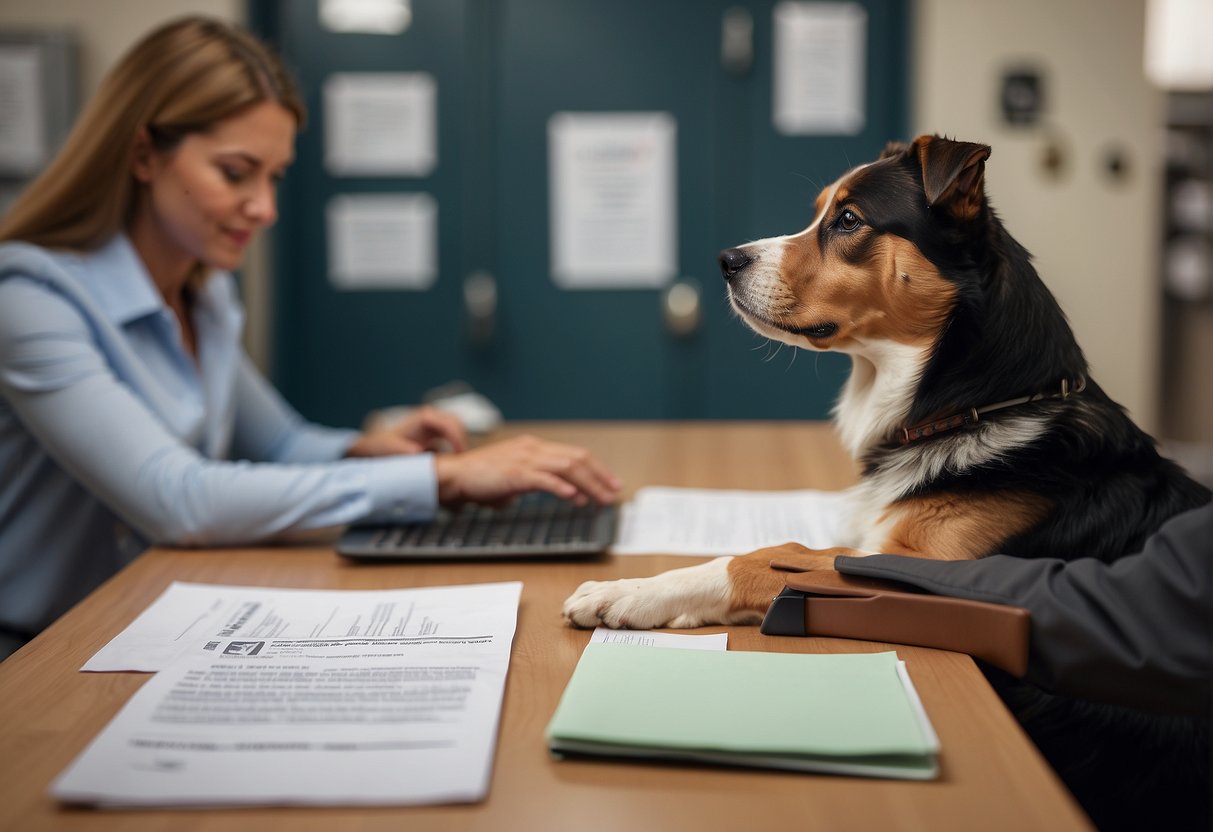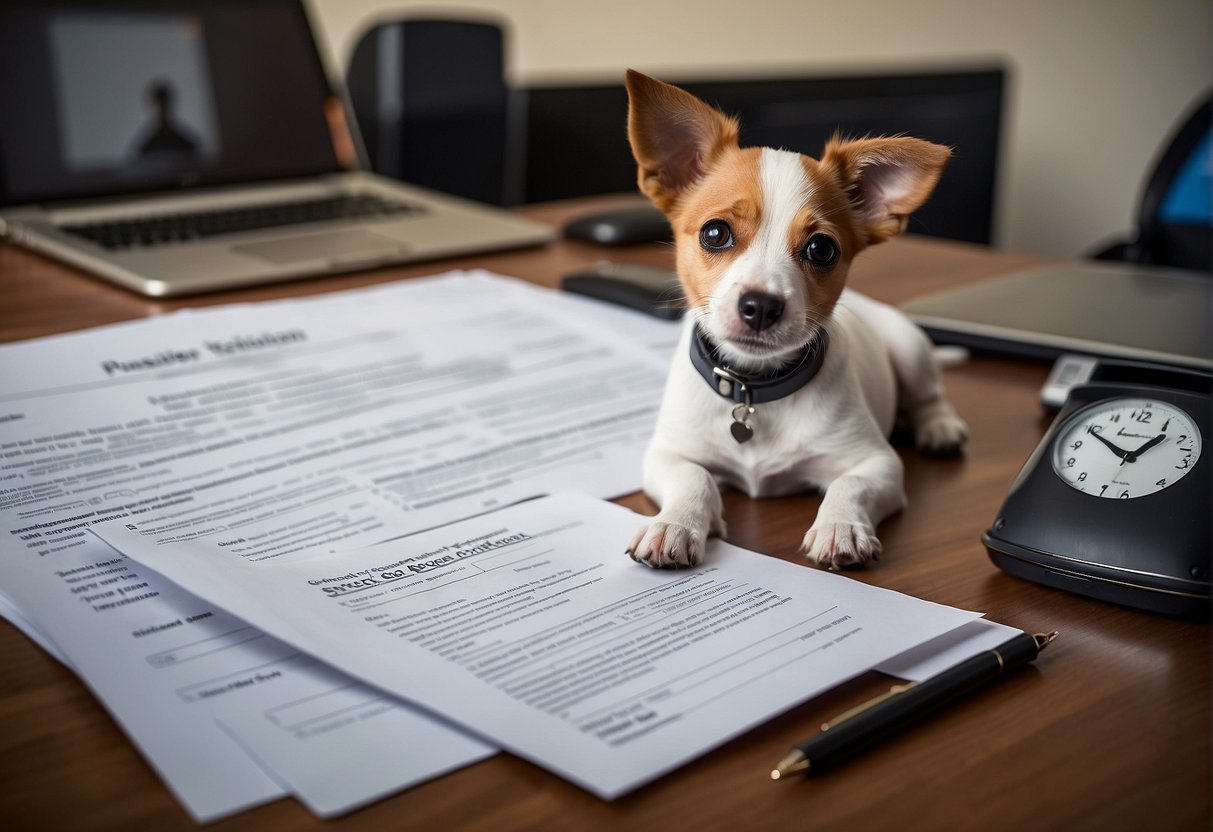When you’ve made the heartwarming decision to adopt a dog, the anticipation can make you impatient to bring your new pet home. However, the adoption process isn’t a same-day service, and various steps must be navigated. A typical dog adoption application process begins with filling out forms that include basic information such as your name and address.
While the exact time can vary, on average, the adoption process for dogs takes about one to three weeks. Shelters and rescue organizations strive to ensure that each pet goes to a compatible home, requiring a thorough review that can take some time.

The duration can be affected by several factors, including the number of applications a shelter is processing, the specific shelter’s policies, and how quickly you can provide requested information or meet adoption requirements. It’s important to research the adoption policies of the shelter you are interested in and prepare for potential visits or interviews.
Being proactive and responsive during the process can help facilitate a quicker and smoother experience.
Key Takeaways
- The dog adoption process involves an application and sometimes multiple steps.
- Typical wait times for bringing a dog home post-application range from one to three weeks.
- Proactively participating in the process and meeting all requirements can speed up the adoption.
Overview of the Dog Adoption Process

Adopting a dog is a journey that involves careful planning and decision-making. This section outlines the critical steps to ensure you’re well-prepared for bringing a new dog into your home.
Initial Research
Before you get started, you need to do some research. Learn about different dog breeds, their needs, and what kind of pet would fit into your lifestyle. Check resources online or get in touch with local experts who can provide insights. Consider your living situation and daily schedule because these factors will influence the kind of dog that’s best for you. Compile a list of qualities you’re looking for in a dog, which could include size, energy level, and temperament.
Choosing the Right Shelter or Rescue
Local shelters and rescues are excellent places to find your new companion. Each shelter and rescue organization operates a bit differently, so it’s important to understand their processes. You might start with a local shelter, such as the Humane Society, or search for specialized rescue groups that focus on particular breeds.
While researching, look at the visiting hours, the adoption policy, and whether you can interact with the dogs before adoption. Choose a few options and visit them to see the dogs available and how the staff supports the adoption process. This personal visit will also give you a sense of how the organizations operate and their level of care for the animals.
Steps in the Dog Adoption Application Process
Submission of Application
Review by Shelter Staff
Interviews and Home Visits
Meeting Potential Pets
Approval and Finalization
Factors Affecting Duration of the Adoption Process

When you decide to adopt a dog, you’re probably eager to bring your new pal home as soon as possible. But it’s not like picking out a new pair of shoes; there’s a process, and its length can vary quite a bit. Here are some things that will affect how long you might be waiting.
Shelter Policies and Procedures
Every shelter has its own way of doing things, like a special secret recipe. Shelters have different application forms, interview requirements, and ways to check if you and the dog are a good fit. Some might check on how your new buddy will live at your place, while others might have a faster, more streamlined process.
Applicant’s Background Check
They’re going to check you out to make sure you’re all good to adopt. Background checks can include looking at your home situation, your past with pets, and if your lifestyle is a match for a dog. If they find everything in order quickly, you’re one step closer to adoption!
Availability of Staff and Volunteers
Shelters run on people power, and sometimes there just aren’t enough hands on deck. The community’s help matters. Volunteers make things move faster, but if they’re short-staffed, you might find yourself waiting a bit longer.
Response Times for References
If you’ve listed some references, the shelter will give them a ring to vouch for you. But if your references don’t pick up the phone pronto or take their time getting back to the shelter, it can stretch out the timeline. Make sure to give a heads-up to your references that someone might be calling.
Average Timeframe for Adoption

When you’re looking to adopt a dog, understanding the timeframe for the process is pretty helpful. It gives you an idea of how quickly you might be able to welcome your new pet into your home.
Estimations by Different Organizations
Different places have their own ways of doing things, which means the time it takes to adopt a dog can vary. Shelters, for example, might get you through the process really quick—sometimes in just a few days. On the other hand, rescue groups might take a bit longer, as they often carefully match dogs to new owners, which is a process that can extend from a few days to a few weeks.
Impact of Pet Demand and Shelter Resources
The adoption timeframe is also influenced by how many people want to adopt and what the shelter has in terms of resources. If you’re looking at an animal in high demand—think puppies or specific breeds—you might be in for a bit of a wait. And if the shelter’s staff is super busy or if there aren’t a ton of them, that can also slow things down. But don’t worry, it’s all about making sure it’s the right fit, so it’ll be worth it in the end.
Potential Delays and How to Address Them

When you’re applying to adopt a dog, sometimes things can slow down a bit. Here’s what can hold up your application and what you can do about it.
Incomplete Applications
If you leave out info on your adoption form, it’s like hitting a pause button. Make sure you:
- Check all the required fields before you submit.
- Provide clear answers to questions about your home and lifestyle.
Busy Shelter Periods
Shelters can get super busy, especially around holidays. If you’re waiting longer:
- Visit or call during less busy times.
- Ask the shelter when it’s best to follow up.
Competition for Popular Dogs
Some dogs have a bunch of folks trying to adopt them. To stand out:
- Express your interest clearly to the shelter.
- Show why your home is a great fit.
Be patient, give all the info needed, and keep in regular touch with the shelter. You got this!
Tips for a Smooth and Swift Adoption Process
When you’re looking forward to adding a new dog to your family, understanding the adoption process and what you can do to speed it up is super important. Here are some focused tips to help you get through the application process with ease.

Prepare Necessary Documents
Before you even find the dog you want to adopt, get all your documents in order. You’ll need proof of residence, identification, and often a history of your pet ownership. Shelters might also want to know about your living situation, like if you rent or own your home. Make sure you have these:
- ID: Driver’s license or a state ID.
- Proof of Residence: A utility bill works great.
- Pet History: Vet records of past or current pets if you have them.
- Landlord Info: If you rent, contact details for your landlord can be helpful.
Having these at the ready will show the shelter that you’re serious and well-prepared.
Be Proactive and Follow Up
After you submit your adoption application, don’t just wait around. Call or email the shelter to ensure they received your application and ask if they need anything else. A polite follow-up can keep you at the top of their minds. But remember, don’t be too pushy; these folks are often super busy. Here’s how you can stay on their radar:
- Initial Follow-up: A couple of days after application submission.
- Check-in: Weekly polite check-ins via email or social media if you haven’t heard back.
Build a Good Rapport with the Shelter
When you interact with shelter staff, be friendly and show your enthusiasm for dog adoption. Visit the shelter, if possible, and engage with them on social media by commenting on posts or sharing their content. Building a good relationship could work in your favor during the adoption process. Here’s what could help:
- Visit: Take the time to go to the shelter and meet the staff.
- Social Media Engagement: Like, comment, and share to show your support.
Final Thoughts

When you decide to adopt a dog, you’re starting a rewarding journey. The process varies from one shelter to another, but patience is key. Remember, this is a big commitment, and the shelter’s thoroughness ensures a good match for you and the dog.
Getting to know your potential new companion during the adoption process is exciting. It’s a time to ask questions and learn. While you’re eager to welcome your new dog home, the shelter is equally committed to finding them a secure, loving environment.
Here’s what to keep in mind:
- Preparation: Be ready with the necessary documents and a mindset for possible home visits.
- Patience: Every step, from application to bringing your dog home, might take a few hours to a couple of weeks.
- Openness: Share your lifestyle and expectations with the shelter staff; honesty helps find the best match.
- Flexibility: Be prepared for multiple visits or meetings—it’s all part of ensuring a successful adoption.
Adopting a dog is not a race; it’s more of a matching process. The waiting time reflects the shelter’s responsibility to the dogs and to you as an adopter. Embrace the experience, as it is the starting point of your commitment to a new, loyal companion. Keep your anticipation in check, and soon enough, you’ll have a new buddy by your side.
